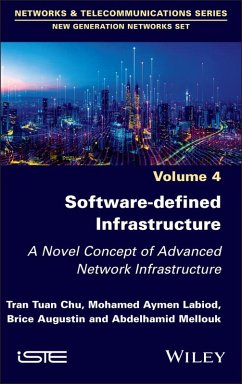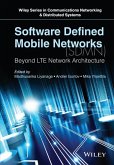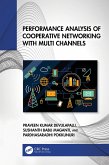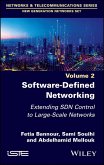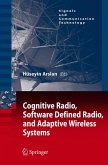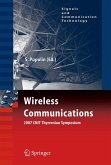Tran Tuan Chu, Mohamed Aymen Labiod, Brice Augustin, Abdelhamid Mellouk
Software-defined Infrastructure (eBook, PDF)
A Novel Concept of Advanced Network Infrastructure
142,99 €
142,99 €
inkl. MwSt.
Sofort per Download lieferbar

0 °P sammeln
142,99 €
Als Download kaufen

142,99 €
inkl. MwSt.
Sofort per Download lieferbar

0 °P sammeln
Jetzt verschenken
Alle Infos zum eBook verschenken
142,99 €
inkl. MwSt.
Sofort per Download lieferbar
Alle Infos zum eBook verschenken

0 °P sammeln
Tran Tuan Chu, Mohamed Aymen Labiod, Brice Augustin, Abdelhamid Mellouk
Software-defined Infrastructure (eBook, PDF)
A Novel Concept of Advanced Network Infrastructure
- Format: PDF
- Merkliste
- Auf die Merkliste
- Bewerten Bewerten
- Teilen
- Produkt teilen
- Produkterinnerung
- Produkterinnerung

Bitte loggen Sie sich zunächst in Ihr Kundenkonto ein oder registrieren Sie sich bei
bücher.de, um das eBook-Abo tolino select nutzen zu können.
Hier können Sie sich einloggen
Hier können Sie sich einloggen
Sie sind bereits eingeloggt. Klicken Sie auf 2. tolino select Abo, um fortzufahren.

Bitte loggen Sie sich zunächst in Ihr Kundenkonto ein oder registrieren Sie sich bei bücher.de, um das eBook-Abo tolino select nutzen zu können.
In the era of the Internet of Things (IoT) and Digital Twins (DT), network infrastructures are rapidly evolving to meet industrial demands. Thus, we were motivated to explore the changing landscape of network deployment, management and utilization, driven by the rise of connected devices and emerging challenges. Software-defined Infrastructure focuses on the cutting-edge shift in hardware deployment and communication management methods, which enable unified, scalable and adaptive network management to support Healthcare IoT (H-IoT) communication, where real-time data transmission is essential…mehr
- Geräte: PC
- mit Kopierschutz
- eBook Hilfe
- Größe: 11.59MB
Andere Kunden interessierten sich auch für
![Green Software Defined Radios (eBook, PDF) Green Software Defined Radios (eBook, PDF)]() Liesbet Van Der PerreGreen Software Defined Radios (eBook, PDF)72,95 €
Liesbet Van Der PerreGreen Software Defined Radios (eBook, PDF)72,95 €![Software Defined Mobile Networks (SDMN) (eBook, PDF) Software Defined Mobile Networks (SDMN) (eBook, PDF)]() Software Defined Mobile Networks (SDMN) (eBook, PDF)90,99 €
Software Defined Mobile Networks (SDMN) (eBook, PDF)90,99 €![Performance Analysis of Cooperative Networking with Multi Channels (eBook, PDF) Performance Analysis of Cooperative Networking with Multi Channels (eBook, PDF)]() Praveen Kumar DevulapalliPerformance Analysis of Cooperative Networking with Multi Channels (eBook, PDF)52,95 €
Praveen Kumar DevulapalliPerformance Analysis of Cooperative Networking with Multi Channels (eBook, PDF)52,95 €![Software-Defined Networking 2 (eBook, PDF) Software-Defined Networking 2 (eBook, PDF)]() Fetia BannourSoftware-Defined Networking 2 (eBook, PDF)126,99 €
Fetia BannourSoftware-Defined Networking 2 (eBook, PDF)126,99 €![Cognitive Radio, Software Defined Radio, and Adaptive Wireless Systems (eBook, PDF) Cognitive Radio, Software Defined Radio, and Adaptive Wireless Systems (eBook, PDF)]() Cognitive Radio, Software Defined Radio, and Adaptive Wireless Systems (eBook, PDF)112,95 €
Cognitive Radio, Software Defined Radio, and Adaptive Wireless Systems (eBook, PDF)112,95 €![Mobile and Wireless Network Security and Privacy (eBook, PDF) Mobile and Wireless Network Security and Privacy (eBook, PDF)]() Mobile and Wireless Network Security and Privacy (eBook, PDF)112,95 €
Mobile and Wireless Network Security and Privacy (eBook, PDF)112,95 €![Wireless Communications 2007 CNIT Thyrrenian Symposium (eBook, PDF) Wireless Communications 2007 CNIT Thyrrenian Symposium (eBook, PDF)]() Wireless Communications 2007 CNIT Thyrrenian Symposium (eBook, PDF)72,95 €
Wireless Communications 2007 CNIT Thyrrenian Symposium (eBook, PDF)72,95 €-
-
-
In the era of the Internet of Things (IoT) and Digital Twins (DT), network infrastructures are rapidly evolving to meet industrial demands. Thus, we were motivated to explore the changing landscape of network deployment, management and utilization, driven by the rise of connected devices and emerging challenges. Software-defined Infrastructure focuses on the cutting-edge shift in hardware deployment and communication management methods, which enable unified, scalable and adaptive network management to support Healthcare IoT (H-IoT) communication, where real-time data transmission is essential to system success. The book presents a novel network concept and solutions for tackling the challenges in key areas such as 5G, and beyond, in network management, multipath transport protocols and edge computing. This book aims to simplify network management, improve remote patient monitoring communication and enhance patient outcomes. Through case studies and theoretical models, the book offers insights into the transformation of advanced networks in the H-IoT context and lays the foundation for innovative ideas in this research domain.
Dieser Download kann aus rechtlichen Gründen nur mit Rechnungsadresse in D ausgeliefert werden.
Produktdetails
- Produktdetails
- Verlag: Wiley
- Seitenzahl: 208
- Erscheinungstermin: 11. Juni 2025
- Englisch
- ISBN-13: 9781394388585
- Artikelnr.: 74407168
- Verlag: Wiley
- Seitenzahl: 208
- Erscheinungstermin: 11. Juni 2025
- Englisch
- ISBN-13: 9781394388585
- Artikelnr.: 74407168
- Herstellerkennzeichnung Die Herstellerinformationen sind derzeit nicht verfügbar.
Tran Tuan Chu obtained his PhD from Paris-Est Créteil University (UPEC), France, in 2023. His research focuses on Software-Defined Infrastructure, and IoT-Digital Twins.
Mohamed Aymen Labiod is Associate Professor at UPEC, France. His research focuses on 5G and 6G architectures, network slicing, mobile and multiaccess networks and multi-connectivity, among other topics.
Brice Augustin is Associate Professor at UPEC, France. His research focuses on Quality of Experience (QoE) in 5G and cloud-based multimedia services, exploring adaptive network mechanisms and edge computing.
Abdelhamid Mellouk is Full-time University Professor, Director of the IT4H High School Engineering Department and Head of the TincNET Research Team, UPEC, France. He is also the founder of Network Control Research and Curricula activities at UPEC, President of the Policies and Programs commission at the National Council for Scientific Research and Technologies, a HCERES Expert, a CNU member and Co-President of the DS-AI Systematic Deep Tech Hub.
Mohamed Aymen Labiod is Associate Professor at UPEC, France. His research focuses on 5G and 6G architectures, network slicing, mobile and multiaccess networks and multi-connectivity, among other topics.
Brice Augustin is Associate Professor at UPEC, France. His research focuses on Quality of Experience (QoE) in 5G and cloud-based multimedia services, exploring adaptive network mechanisms and edge computing.
Abdelhamid Mellouk is Full-time University Professor, Director of the IT4H High School Engineering Department and Head of the TincNET Research Team, UPEC, France. He is also the founder of Network Control Research and Curricula activities at UPEC, President of the Policies and Programs commission at the National Council for Scientific Research and Technologies, a HCERES Expert, a CNU member and Co-President of the DS-AI Systematic Deep Tech Hub.
Preface ix
List of Acronyms xiii
Introduction xvii
Chapter 1 Healthcare Internet of Things: The State of the Art 1
1.1 H-IoT network landscape 2
1.2 Technology emergence in H-IoT 10
1.2.1 Edge computing in H-IoT 12
1.2.2 Software-defined network in H-IoT 16
1.3. Learned lessons and neglected opportunities 28
1.3.1 Learned lessons 28
1.3.2 Neglected opportunities 37
1.4 Conclusion 38
Chapter 2. A Novel Network Infrastructure Concept 39
2.1 Introduction 39
2.2 Related work 44
2.2.1 Software-defined network 45
2.2.2 5G novel network perspective 45
2.2.3 Software-defined infrastructure 46
2.2.4 Software-defined vehicular network 47
2.2.5 Software-defined unmanned aerial vehicular network 48
2.2.6 Other potential software-defined hardware blocks 49
2.3 The evolution of SDI 50
2.3.1 Research gap 50
2.3.2 SDI extension 51
2.3.3 Proposal of our architecture 52
2.3.4 Suggested technology adjustments 54
2.3.5 Prospective interaction within the SDI ecosystem 56
2.3.6 Software-defined infrastructure's benefit recap 57
2.4 Unified functional model formalization 58
2.4.1 Description of the model 58
2.4.2 Structure of the model 59
2.5 Description of the experiments 64
2.5.1 Implementation details 66
2.5.2 Approach 1: opportunistic coverage enhancement 71
2.5.3 Approach 2: connection recovery 72
2.5.4 Approach 3: self-assisted coverage deployment and data transportation
74
2.5.5 Approach 4: priority orchestration in high-density network 76
2.6 Improvement evaluation approaches 78
2.6.1 Opportunistic coverage enhancement 78
2.6.2 Connection recovery 80
2.6.3 Self-assisted coverage deployment and data transportation 82
2.6.4 Priority orchestration in high-density network 83
2.7 Conclusion 86
Chapter 3 SMART Connection Migration 89
3.1 Introduction 89
3.2 Related work 92
3.2.1 Virtual machine migration 93
3.2.2 Container migration 93
3.2.3 TCP-based connection migration 94
3.2.4 QUIC-based connection migration 95
3.2.5 Motivation 96
3.3 Solution design 97
3.3.1 Sequence diagram comparison 97
3.3.2 System design 98
3.3.3 Prospective impact 99
3.4 Performance evaluation 100
3.4.1 Experimental environment 100
3.4.2 Experiment scenario 101
3.4.3 Influence of delay on the connection migration process 103
3.4.4 The influence of migration frequency on the connection migration time
103
3.5 Conclusion 104
Chapter 4 Generic Adaptive Deep Learning-based Multipath Scheduler Selector
107
4.1 Introduction 107
4.2 Related work 110
4.2.1 Multipath transport protocols 110
4.2.2 Multipath scheduling algorithms 111
4.2.3 Multipath scheduling performance over heterogeneous paths 113
4.3 Prototype design 114
4.3.1 Scheduler selector paradigm 114
4.3.2 Prototype design 115
4.4 Simulated evaluation 117
4.4.1 Experiment setup 117
4.4.2 Initial dataset analysis 119
4.4.3 Traditional machine learning's performance evaluation 121
4.4.4 Deep learning's performance evaluation 123
4.5 Practical evaluation 125
4.5.1 Brief overview of GADaM 125
4.5.2 Extensible modular scheduler evaluating framework 128
4.5.3 Experiment environment 129
4.5.4 Trial run 132
4.5.5 Actual run 136
4.5.6 In-house static environment 138
4.5.7 Metro line environment 139
4.5.8 In-vehicle environment 140
4.6 Limitations 143
4.7 Conclusion 145
Conclusions and Perspectives 147
References 151
Index 171
List of Acronyms xiii
Introduction xvii
Chapter 1 Healthcare Internet of Things: The State of the Art 1
1.1 H-IoT network landscape 2
1.2 Technology emergence in H-IoT 10
1.2.1 Edge computing in H-IoT 12
1.2.2 Software-defined network in H-IoT 16
1.3. Learned lessons and neglected opportunities 28
1.3.1 Learned lessons 28
1.3.2 Neglected opportunities 37
1.4 Conclusion 38
Chapter 2. A Novel Network Infrastructure Concept 39
2.1 Introduction 39
2.2 Related work 44
2.2.1 Software-defined network 45
2.2.2 5G novel network perspective 45
2.2.3 Software-defined infrastructure 46
2.2.4 Software-defined vehicular network 47
2.2.5 Software-defined unmanned aerial vehicular network 48
2.2.6 Other potential software-defined hardware blocks 49
2.3 The evolution of SDI 50
2.3.1 Research gap 50
2.3.2 SDI extension 51
2.3.3 Proposal of our architecture 52
2.3.4 Suggested technology adjustments 54
2.3.5 Prospective interaction within the SDI ecosystem 56
2.3.6 Software-defined infrastructure's benefit recap 57
2.4 Unified functional model formalization 58
2.4.1 Description of the model 58
2.4.2 Structure of the model 59
2.5 Description of the experiments 64
2.5.1 Implementation details 66
2.5.2 Approach 1: opportunistic coverage enhancement 71
2.5.3 Approach 2: connection recovery 72
2.5.4 Approach 3: self-assisted coverage deployment and data transportation
74
2.5.5 Approach 4: priority orchestration in high-density network 76
2.6 Improvement evaluation approaches 78
2.6.1 Opportunistic coverage enhancement 78
2.6.2 Connection recovery 80
2.6.3 Self-assisted coverage deployment and data transportation 82
2.6.4 Priority orchestration in high-density network 83
2.7 Conclusion 86
Chapter 3 SMART Connection Migration 89
3.1 Introduction 89
3.2 Related work 92
3.2.1 Virtual machine migration 93
3.2.2 Container migration 93
3.2.3 TCP-based connection migration 94
3.2.4 QUIC-based connection migration 95
3.2.5 Motivation 96
3.3 Solution design 97
3.3.1 Sequence diagram comparison 97
3.3.2 System design 98
3.3.3 Prospective impact 99
3.4 Performance evaluation 100
3.4.1 Experimental environment 100
3.4.2 Experiment scenario 101
3.4.3 Influence of delay on the connection migration process 103
3.4.4 The influence of migration frequency on the connection migration time
103
3.5 Conclusion 104
Chapter 4 Generic Adaptive Deep Learning-based Multipath Scheduler Selector
107
4.1 Introduction 107
4.2 Related work 110
4.2.1 Multipath transport protocols 110
4.2.2 Multipath scheduling algorithms 111
4.2.3 Multipath scheduling performance over heterogeneous paths 113
4.3 Prototype design 114
4.3.1 Scheduler selector paradigm 114
4.3.2 Prototype design 115
4.4 Simulated evaluation 117
4.4.1 Experiment setup 117
4.4.2 Initial dataset analysis 119
4.4.3 Traditional machine learning's performance evaluation 121
4.4.4 Deep learning's performance evaluation 123
4.5 Practical evaluation 125
4.5.1 Brief overview of GADaM 125
4.5.2 Extensible modular scheduler evaluating framework 128
4.5.3 Experiment environment 129
4.5.4 Trial run 132
4.5.5 Actual run 136
4.5.6 In-house static environment 138
4.5.7 Metro line environment 139
4.5.8 In-vehicle environment 140
4.6 Limitations 143
4.7 Conclusion 145
Conclusions and Perspectives 147
References 151
Index 171
Preface ix
List of Acronyms xiii
Introduction xvii
Chapter 1 Healthcare Internet of Things: The State of the Art 1
1.1 H-IoT network landscape 2
1.2 Technology emergence in H-IoT 10
1.2.1 Edge computing in H-IoT 12
1.2.2 Software-defined network in H-IoT 16
1.3. Learned lessons and neglected opportunities 28
1.3.1 Learned lessons 28
1.3.2 Neglected opportunities 37
1.4 Conclusion 38
Chapter 2. A Novel Network Infrastructure Concept 39
2.1 Introduction 39
2.2 Related work 44
2.2.1 Software-defined network 45
2.2.2 5G novel network perspective 45
2.2.3 Software-defined infrastructure 46
2.2.4 Software-defined vehicular network 47
2.2.5 Software-defined unmanned aerial vehicular network 48
2.2.6 Other potential software-defined hardware blocks 49
2.3 The evolution of SDI 50
2.3.1 Research gap 50
2.3.2 SDI extension 51
2.3.3 Proposal of our architecture 52
2.3.4 Suggested technology adjustments 54
2.3.5 Prospective interaction within the SDI ecosystem 56
2.3.6 Software-defined infrastructure's benefit recap 57
2.4 Unified functional model formalization 58
2.4.1 Description of the model 58
2.4.2 Structure of the model 59
2.5 Description of the experiments 64
2.5.1 Implementation details 66
2.5.2 Approach 1: opportunistic coverage enhancement 71
2.5.3 Approach 2: connection recovery 72
2.5.4 Approach 3: self-assisted coverage deployment and data transportation
74
2.5.5 Approach 4: priority orchestration in high-density network 76
2.6 Improvement evaluation approaches 78
2.6.1 Opportunistic coverage enhancement 78
2.6.2 Connection recovery 80
2.6.3 Self-assisted coverage deployment and data transportation 82
2.6.4 Priority orchestration in high-density network 83
2.7 Conclusion 86
Chapter 3 SMART Connection Migration 89
3.1 Introduction 89
3.2 Related work 92
3.2.1 Virtual machine migration 93
3.2.2 Container migration 93
3.2.3 TCP-based connection migration 94
3.2.4 QUIC-based connection migration 95
3.2.5 Motivation 96
3.3 Solution design 97
3.3.1 Sequence diagram comparison 97
3.3.2 System design 98
3.3.3 Prospective impact 99
3.4 Performance evaluation 100
3.4.1 Experimental environment 100
3.4.2 Experiment scenario 101
3.4.3 Influence of delay on the connection migration process 103
3.4.4 The influence of migration frequency on the connection migration time
103
3.5 Conclusion 104
Chapter 4 Generic Adaptive Deep Learning-based Multipath Scheduler Selector
107
4.1 Introduction 107
4.2 Related work 110
4.2.1 Multipath transport protocols 110
4.2.2 Multipath scheduling algorithms 111
4.2.3 Multipath scheduling performance over heterogeneous paths 113
4.3 Prototype design 114
4.3.1 Scheduler selector paradigm 114
4.3.2 Prototype design 115
4.4 Simulated evaluation 117
4.4.1 Experiment setup 117
4.4.2 Initial dataset analysis 119
4.4.3 Traditional machine learning's performance evaluation 121
4.4.4 Deep learning's performance evaluation 123
4.5 Practical evaluation 125
4.5.1 Brief overview of GADaM 125
4.5.2 Extensible modular scheduler evaluating framework 128
4.5.3 Experiment environment 129
4.5.4 Trial run 132
4.5.5 Actual run 136
4.5.6 In-house static environment 138
4.5.7 Metro line environment 139
4.5.8 In-vehicle environment 140
4.6 Limitations 143
4.7 Conclusion 145
Conclusions and Perspectives 147
References 151
Index 171
List of Acronyms xiii
Introduction xvii
Chapter 1 Healthcare Internet of Things: The State of the Art 1
1.1 H-IoT network landscape 2
1.2 Technology emergence in H-IoT 10
1.2.1 Edge computing in H-IoT 12
1.2.2 Software-defined network in H-IoT 16
1.3. Learned lessons and neglected opportunities 28
1.3.1 Learned lessons 28
1.3.2 Neglected opportunities 37
1.4 Conclusion 38
Chapter 2. A Novel Network Infrastructure Concept 39
2.1 Introduction 39
2.2 Related work 44
2.2.1 Software-defined network 45
2.2.2 5G novel network perspective 45
2.2.3 Software-defined infrastructure 46
2.2.4 Software-defined vehicular network 47
2.2.5 Software-defined unmanned aerial vehicular network 48
2.2.6 Other potential software-defined hardware blocks 49
2.3 The evolution of SDI 50
2.3.1 Research gap 50
2.3.2 SDI extension 51
2.3.3 Proposal of our architecture 52
2.3.4 Suggested technology adjustments 54
2.3.5 Prospective interaction within the SDI ecosystem 56
2.3.6 Software-defined infrastructure's benefit recap 57
2.4 Unified functional model formalization 58
2.4.1 Description of the model 58
2.4.2 Structure of the model 59
2.5 Description of the experiments 64
2.5.1 Implementation details 66
2.5.2 Approach 1: opportunistic coverage enhancement 71
2.5.3 Approach 2: connection recovery 72
2.5.4 Approach 3: self-assisted coverage deployment and data transportation
74
2.5.5 Approach 4: priority orchestration in high-density network 76
2.6 Improvement evaluation approaches 78
2.6.1 Opportunistic coverage enhancement 78
2.6.2 Connection recovery 80
2.6.3 Self-assisted coverage deployment and data transportation 82
2.6.4 Priority orchestration in high-density network 83
2.7 Conclusion 86
Chapter 3 SMART Connection Migration 89
3.1 Introduction 89
3.2 Related work 92
3.2.1 Virtual machine migration 93
3.2.2 Container migration 93
3.2.3 TCP-based connection migration 94
3.2.4 QUIC-based connection migration 95
3.2.5 Motivation 96
3.3 Solution design 97
3.3.1 Sequence diagram comparison 97
3.3.2 System design 98
3.3.3 Prospective impact 99
3.4 Performance evaluation 100
3.4.1 Experimental environment 100
3.4.2 Experiment scenario 101
3.4.3 Influence of delay on the connection migration process 103
3.4.4 The influence of migration frequency on the connection migration time
103
3.5 Conclusion 104
Chapter 4 Generic Adaptive Deep Learning-based Multipath Scheduler Selector
107
4.1 Introduction 107
4.2 Related work 110
4.2.1 Multipath transport protocols 110
4.2.2 Multipath scheduling algorithms 111
4.2.3 Multipath scheduling performance over heterogeneous paths 113
4.3 Prototype design 114
4.3.1 Scheduler selector paradigm 114
4.3.2 Prototype design 115
4.4 Simulated evaluation 117
4.4.1 Experiment setup 117
4.4.2 Initial dataset analysis 119
4.4.3 Traditional machine learning's performance evaluation 121
4.4.4 Deep learning's performance evaluation 123
4.5 Practical evaluation 125
4.5.1 Brief overview of GADaM 125
4.5.2 Extensible modular scheduler evaluating framework 128
4.5.3 Experiment environment 129
4.5.4 Trial run 132
4.5.5 Actual run 136
4.5.6 In-house static environment 138
4.5.7 Metro line environment 139
4.5.8 In-vehicle environment 140
4.6 Limitations 143
4.7 Conclusion 145
Conclusions and Perspectives 147
References 151
Index 171
